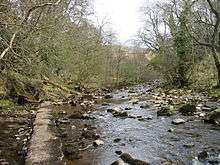River Gelt
The River Gelt is a river in Cumbria, England and a tributary of the River Irthing.

The source of the Gelt is close to Cumbria's border with Northumberland, where it rises (as New Water) at Butt Hill. The stream runs down Geltsdale Middle in the direction of Cumrew Fell, before turning northwards.
After a short while, New Water is joined by Old Water in the King's Forest of Geltsdale. Old Water runs from Crookburn Pike. After the two streams combine, the river continues flowing to the northwest, passing between Talkin Fell and Castle Carrock Fell, then the villages of the same names.
Having flown through Greenwell and under the Newcastle and Carlisle Railway, the Gelt continues through Gelt Woods, overlooked by a Roman inscription dating from 207 AD and known as "the written rock of Gelt".[1] Other stories and legends are associated with Abraham's Cave.[2] In 1570 it saw the Battle of Gelt Bridge, when Leonard Dacre and his forces were defeated by Henry Carey, 1st Baron Hunsdon, cousin of Queen Elizabeth I.
The Gelt joins the River Irthing at Edmond Castle, about 10 miles east of Carlisle.
Written rock of Gelt
The Romans quarried the soft sandstone for use in Hadrian's Wall, which lies three miles to the north. It was abandoned in 207 AD. On the rockface there was extensive carved graffiti, that has been known since the eighteenth century. It included notes, comments about the officers and a lucky symbolic penis (phallus). In 2019 the archaeology department of the University of Newcastle undertook a 3D scan of the site discovering it was more extensive than previously thought.[3]
The task involves descending by rope or in a gantry, 30 feet (9.1 m) into the quarry and recording the rock face using structure-from-motion (SfM) photogrammetry. The site was accessible by foot before the path collapsed 30 years ago.[4]
"These inscriptions are probably the most important on the Hadrian's Wall frontier." The inspector of ancient monuments for Hadrian's Wall at Historic England, Mike Collins, said. "They provide insight into the organisation of the vast construction project that Hadrian's Wall was, as well as some very human and personal touches, such as the caricature of their commanding officer inscribed by one group of soldiers."[5]
Etymology
The Gelt name is of Brittonic origin and derived from *wïlt, meaning "wild, uncontrolled" (Welsh gwyllt).[6] The same word underlies the Gelt Burn in Northumberland.[6]
References
- Brown, Mark (27 February 2019). "Rare Roman graffiti in Cumbria quarry to be captured in 3D". The Guardian. Retrieved 27 February 2019.
- Legends Flow Freely in the Valley of the Gelt, The Whitehaven News. Retrieved 12 September 2006.
- "How Roman solidiers repairing Hadrian's Wall left behind a surprising good luck symbol". www.msn.com. Retrieved 27 February 2019.
- Trott, Fiona (27 February 2019). "1,800-year-old Roman graffiti recorded". Retrieved 28 February 2019.
- "Publius aelius Hadrianus est hic: Roman Graffiti found in Cumbrian quarry". KL.FM 96.7. 27 February 2019. Retrieved 27 February 2019.
- James, Alan. "A Guide to the Place-Name Evidence" (PDF). SPNS - The Brittonic Language in the Old North. Retrieved 25 November 2018.